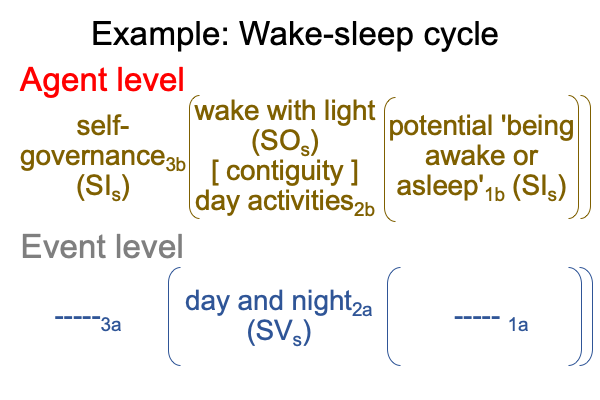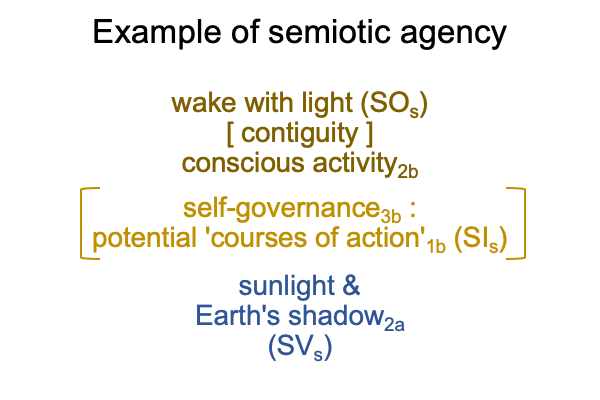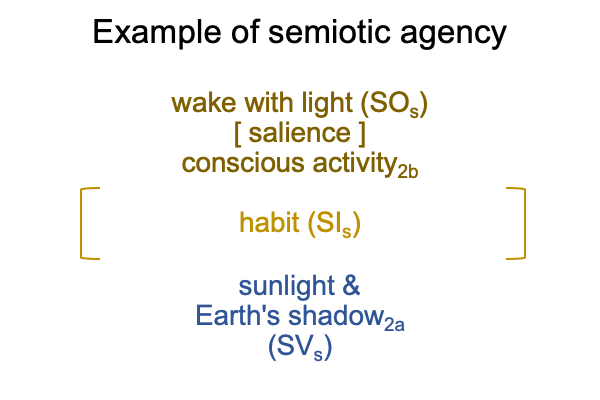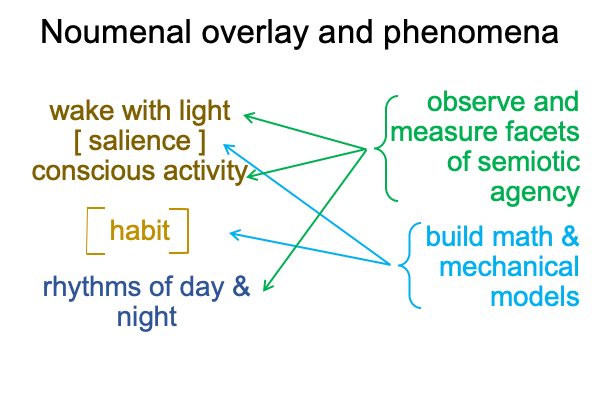0048 So far, so good. The next question wonders, “Does this noumenal overlay work? Can the scientist readily appreciate which elements give rise to phenomena and which need to be accounted for by a model?”
0049 I proceed by way of example.
Consider a metabolic thing such as a circadian rhythm for waking and sleeping. The content-level actualities2a are “sunlight” and “lack of sunlight”. Sunlight2a (SVs) stands for “being awake”2b (SOs) according to an animal’s self-governance3b operating on the potential of two metabolic states’1b (SIs).
Here is Kull’s interscope.

0050 Yes, I can recognize this interscope as a noumenon, but the items that give rise to phenomena and the processes that need mechanistic models are not obvious. Maybe, the SVs and SOs support phenomena and SIs needs to be accounted for by a model.
0051 Sharov and Tonnessen’s dyadic noumenal overlay formalizes this intuition and conveys the fact that all examples of semiotic agency have one (easily interpreted) dyadic actuality in common.
This example is no exception.

Phenomena follow form and matter (SVs and SOs). The contiguities (SIs and resonant contiguity) call for models.
0052 Surely, some simplifications may assist.
In particular, the contiguities should be made more accessible.
Fortunately, the English vernacular offers two words that fit the bill.
0053 The first is “habit”. “Habit” is a spoken word that labels the SIs. A “habit” goes with the explicit abstraction where self-governance3b serves as a normal context to the potential of ‘various courses of action’1b. Yes, our civilization already appropriated a label for this explicit abstraction. That is promising.
On top of that, “habit” sounds like a formal cause and may serve as a final cause.
0054 The second is “salience”. “Salience” is a spoken word that labels the contiguity between a specifying sign-object (SOs) and an end (or final cause). That “end” may be “a goal”, “a purpose” or “an intention”.
0054 Here is a picture of a simplified S&T’s noumenal overlay for this example.

0055 Surely, the elements that give rise to phenomena and the elements that must be accounted for by models stand out.
But, since I am not above pointing out the obvious, here are my associations.

May I summarize?
I start with an agent as a noumenon and Kull’s criteria as phenomena.
I end by combining both agent and Kull’s criteria in a triadic structure of semiotic agency that is at once a two-level interscope and a specifying sign-relation.
Then, Sharov and Tonnessen offer the opportunity to simplify this complicated triadic structure into a (science friendly) dyadic structure.
Now, Sharov and Tonnessen’s dyadic rendering of semiotic agency serves as a noumenal overlay that works as subject matter for biosemiotic inquiry.
